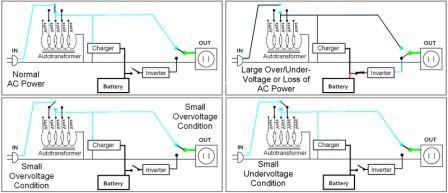Offline UPS
Offline UPS supply grid power to electrical and electronic devices during normal power supply. It switches to battery power only during power failures and other power problems. As the grid power is bypassed to the load during normal power supply, it is known as Offline UPS. As the UPS is used only during power problems it is also known as Standby UPS. Offline UPS is also spelled as Off-Line UPS or Off Line UPS.
Apart from bypassing power to the load, Offline UPS also
charges the connected batteries during normal power supply. The bypassing of power results in exposing the load to electrical noises and surges. Therefore, they are not recommended for very sensitive and critical electronic devices. During power failures and other power problems, they switch from grid power to battery power fast enough to prevent computers from rebooting. The switch over time is usually between 2 to 20ms.
Online UPS
Online UPS supply power to electrical and electronic devices from batteries all the time. The UPS first converts grid power to charge the batteries and then discharges the batteries to power the load. As the battery power is supplied to the load at all times, it is known as Online UPS. The grid power is converted from (Alternating Current) AC to DC (Direct Current) to charge the battery and the battery power is converted from DC to AC to power the load. Therefore online UPS is also known as Double Conversion UPS.
As Online UPS always provides power from the battery, the load always gets clean power regardless of any power problems. Therefore, Online UPS is recommended for sensitive and critical electronic devices. Online UPS provide a layer of insulation or electric firewall. Any change in the input voltage or frequency does not affect the output voltage and frequency. Therefore, the load is shielded from all power problems.
Another one type of UPS is
Another one type of UPS is line interactive UPS.

This is similar to Offline UPS, with a multi-tap variable-voltage autotransformer.
This is the one which we use mostly at home for 10 to 20 minutes backup.
At the time of failure, it switches to battery mode within few micro seconds, which is tolerable. So, you can't face any interrupt. This type of UPS is able to tolerate continuous undervoltage brownouts and overvoltage surges without consuming the limited reserve battery power.
(+) Low cost
(+) Safeguards system from overvoltage / undervoltage
(+) Fewer parts lower operating temperature
(+) Lower initial cost (fewer parts) Lower operating cost (less electricity)
(-) Rarely, at the time of power failure, battery mode switching time increases which interrupts the connected system.


Online UPS:- (For Computer Systems)
(-) Many parts higher operating temperature
(-) Higher initial cost (more parts) Higher operating cost (more electricity)
(+) Accepts extreme voltage distortion without going to battery
(+) Output fixed to a configurable frequency
Offline UPS:- (For ordinary use for Lights, Fans)
(+) Fewer parts lower operating temperature
(+) Lower initial cost (fewer parts) Lower operating cost (less electricity)
(-) Extreme voltage distortion can require frequent battery usage
(-) Output frequency varies within a configurable range